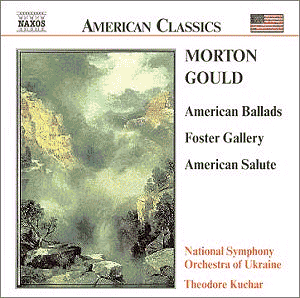Morton GOULD (1913-1996)
American Ballads (1976) Foster Gallery (1939) American
Salute (1947)
 National Symphony Orchestra
of Ukraine/Theodore Kuchar
National Symphony Orchestra
of Ukraine/Theodore Kuchar
Rec. Grand Hall of the National Radio Company of Ukraine 2-14 June 1999
 NAXOS American Classics
8.559005 DDD
[73:48]
NAXOS American Classics
8.559005 DDD
[73:48]
Crotchet
AmazonUK
AmazonUS

I have often thought of Morton Gould as being akin to an American Malcolm
Arnold, prodigiously talented and yet cast aside somewhat in the "serious"
musical world as a composer of light music. Gould may not have produced a
symphonic cycle of the depth and gravity of Arnold but if one sets aside
the surface glitz of his music there is much to uncover. The influence of
Aaron Copland is there but so are a few surprises. I was struck by the number
of times that William Schuman came to mind, even in the early Foster Gallery
with its imaginative treatment of such well known tunes as Camptown
Races and Jeannie with the Light Brown Hair.
Gould was a child prodigy. Born in Long Island, New York, at the age of four
he was already playing the piano and composing, having his first piece published
at the tender age of six. By the age of eight he was performing on New York
radio and after academic studies it was vaudeville and the radio that both
earned him a living and gave him an outlet for his talents. His sparkling
arrangements of popular music became particularly well known although he
was also producing a steady flow of original compositions, all of which were
marked by his customary brilliant orchestration.
The Foster Gallery was one of his early successes in the field of
"popular" music, written in 1939, at the request of Fritz Reiner to whom
the work is dedicated. Gould openly stated that the idea of the work was
largely based on Mussorgsky's Pictures at an Exhibition, with
numerous variations on Camptown Races recurring in the manner of the
"promenade" throughout the work. It is a substantial piece, nearly thirty-five
minutes in length, and there is a huge degree of variety in Gould's often
highly skilful treatment of Stephen Foster's songs and dances which he drew
from the Lilly collection of Fosteriana, "Foster Hall". It is some of the
more unfamiliar tunes which I found most intriguing, particularly the sixth
movement (track twelve), Old Black Joe and My Old Kentucky
Home, with its haunting, slightly eerie opening which returns at the
close. Swanee River is treated to a tongue-in-cheek arrangement for
what Gould described as a "social orchestra" comprising flute, trumpet, trombone,
violin and banjo whilst there are some lovely sonorous brass chorale sounds
in the central climax of Come Where My Love Lies Dreaming (track eight).
The finale, based on Oh, Susanna, forms a suitably riotous conclusion
to the work.
By comparison, American Ballads, is a late work, commissioned in 1976
as a celebration of the United States Bicentennial. It is marked by the same
brilliant, youthfully exuberant orchestration evident in Foster Gallery
and, given the reasons for the commission, it is perhaps no surprise that
Gould once again turned to popular American song as his inspiration (the
composer referred to the tunes as "chestnuts"). The Star-Spangled
Overture with which the work patriotically opens is a characteristically
lively treatment of The Star-Spangled Banner although once again it
is Gould's treatment of the more unfamiliar material that often catches the
attention. The fourth movement, entitled Memorials, is a sombre funeral
march, which makes considerable use of muted brass and for me, recalls the
opening movement of Mahler's Symphony No. 5. Saratoga Quickstep, the
fifth movement, has, as its basis, The Girl I Left Behind Me with
the final Hymnal drawing on We Shall Overcome, a national hymn
of hope which is built to a huge final climax.
In many ways it is ironic, although not perhaps unexpected, that the work
for which Gould became best known is a patriotic miniature. American
Salute is a brief but exciting elaboration of the civil war marching
song, When Johnny Comes Marching Home. It is once again typical of
Gould in popular mode, full of bravado with fanfare-like figures to open
and scored with striking facility. Yet its popularity tends to overshadow
the greater achievements of his musical output. Nevertheless it provides
a fitting and exciting conclusion to the disc.
The National Symphony Orchestra of the Ukraine are fine advocates for these
works, capturing an invigorating feeling of spirit which pervades the whole
disc. I would like to have heard a richer sound from the strings at times
and an American orchestra may have given a slightly greater degree of incision
although, as befits Gould's scoring, the Naxos engineers place the wind and
brass well forward in the balance. The recording is vivid with an impressively
wide dynamic range. Some people may find the brazen Americanism of Gould's
music a little overbearing but I find it irresistible and in performances
such as these this disc has to be considered a first rate bargain.
Christopher Thomas
See also review by Ian Lace

